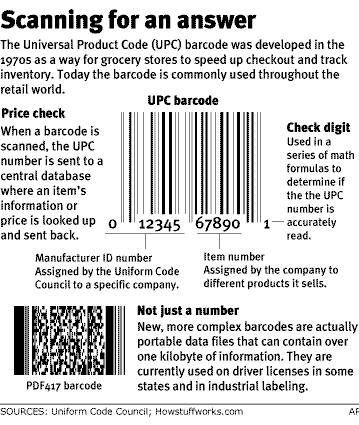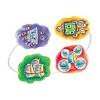 |
 |
 |
|
|
|
|
WAL-MART CONSIDERED the ploy an incitement to theft and sent a
cease-and-desist letter dated April 2 to one of the companies that was
hosting the Web site, Re-code.com. Re-code.com’s operators responded by disabling the link on their Web site that allowed users to print sheets with a selection of bar code labels that could be slapped on store items. “We were advised by our lawyers it would make sense to remove those for now,” said one of the activists, who identified himself only as Nathan Hactivist and responded by telephone to an e-mail request for an interview. Re-code.com still provides a database of bar codes that can be copied and pasted into printing applications. It suggests, for instance, that users stick a label for Nerf balls over the bar code on a box of rifle ammunition. |
||||||||||||||||||||||||||||||||||||||||||||
 Hactivist said he does not know whether anyone has used the replacement bar codes. Re-code’s aim, he said, is to get people to discuss how prices are set. He says Wal-Mart is an appropriate target because of its anti-union stance and the way it crowds out smaller retailers by undercutting their prices. |
|||||||||||||||||||||||||||||||||||||||||||||

|
A
satirical video at the site recommends the use of self check-out counters
- a relatively new retail phenomenon - to reduce the risk of cashiers
noticing the switch. The site also prominently display’s Wal-Mart’s letter. Hactivist said he lives in “upstate New York” but refused to be more specific. The Web site is registered to Mike Bonnano in Loudonville, outside Albany, N.Y. Bonnano said he was not among activists who created the site but was willing to risk being its legal owner. Wal-Mart spokesman Tom Williams said thieves in the past have used fake bar codes, and that the company does not want people using a Web site to print them onto labels. Burt Flickinger, head of the retail business consultancy Strategic Resource Group in New York, said that shoplifting and theft by employees is already a huge problem for retail chains, and is part of the reason 15 of the 100 largest retailers have gone bankrupt in the past year. |
||||||||||||||||||||||||||||||||||||||||||||

Bonnano, the Web site registrant, belongs to The Yes Men, a group of “satirical impostors” that lampoons organizations with a perceived globalization bent. One of the group’s more well-known pranks was to send a member masquerading as a representative of the World Trade Organization to a textile conference in Finland, where he delivered a satirical speech. Bar codes, also known as Universal Product Codes, were introduced in supermarkets 1974 and are now ubiquitous. Besides speeding up check-out, they help stores manage inventories by alerting them when they are running low of a particular product. They are easily duplicated. Several Web sites offer bar codes for printing, but they generally don’t contain a database of codes nor recommend that they be pasted onto products. Businesses are now looking at replacing bar codes with radio-frequency “smart labels,” small chips that can be identified from a short distance without laser scanning, much like anti-theft tags. © 2003 Associated Press. All rights reserved. This material may not be published, broadcast, rewritten or redistributed. |
|||||||||||||||||||||||||||||||||||||||||||||

|
||||||||||
| ||||||||||||||||
| ||||||||||||||||
| ||||||||||||||||
|
|
Advertisement |
|||||||
 Neatsuite NT 100-User $5,799.95 Gateway
Accessory StoreFree Shipping on All Orders
|
|||||||
|
|
|||||||
Hacks, Viruses & Scams
Technology & Science
MSNBC's Top News













.gif)



 Saying 'no thanks'
to the Internet
Saying 'no thanks'
to the Internet